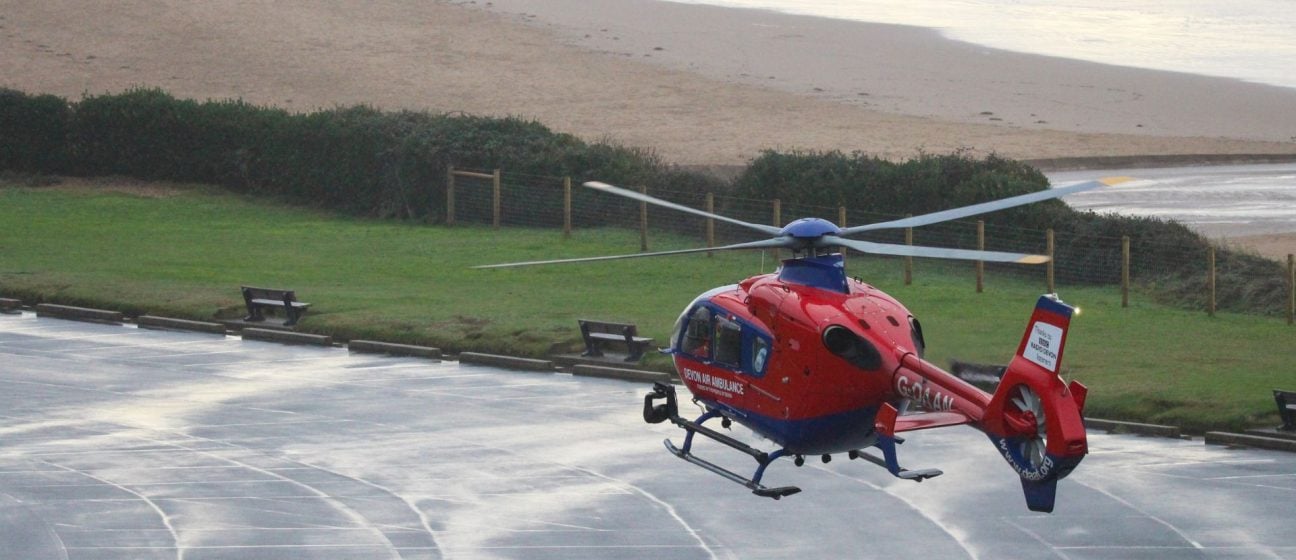
Tens of thousands of lives have been saved in Devon thanks to helicopters. We share some interesting facts about the aircraft.
World Helicopter Day is acknowledged on the third Sunday of August each year to raise awareness of the contributions that helicopters make – not least in the air ambulance sector.
The day is an opportunity to highlight the lifesaving work of organisations such Devon Air Ambulance, which plays a vital role in saving lives across the region.
We operate two specialist aircraft, each kitted out with the same lifesaving equipment that an emergency room is equipped with, to ensure that critical care reaches patients in remote or hard-to-access areas, often within minutes.
Since its inception in 1992, every year we have undertaken hundreds of missions, responding to emergencies such as road traffic collisions, medical crises, and accidents in rural locations. The agility and speed of our helicopters allow us to transcend geographical challenges, delivering advanced care directly to those in need.
World Helicopter Day serves as a reminder of the immense logistical and operational efforts required to sustain such services, which includes continuous fundraising efforts, crucial community and volunteer support, and ensuring that our crew receives the top-tier training they need to continue to advance the care we bring to patients.
The arrival of our aircraft at the scene of an incident is a reassuring sight to local communities. Here are some interesting facts about our aircraft and their capabilities.
Aircraft facts
- Both our aircraft typically flies @ 120 knots when on task, the maximum speed it can fly depends on outside temperature and altitude but is in the region of 150 knots for G-DAAS and 155 knots for G-DAAN.
- Both our G-DAAS and G-DAAN aircraft fly at a maximum height limitation is 20,000 feet. Normally both fly around 2,000 feet en-route to tasks in the cruise.
- G-DAAN is serviced for maintenance every 12 months or 500hrs and G-DAAS is serviced every 12 months or 500hrs (equated to every 8 months based on flying rate).
- Some aircraft have two rotor blades and some have eight. Our aircraft have two. These guarantee enough lift to carry the weight of up to four crew members, a passenger and fuel, which is generally 550kg. The weight of the G-DAAS aircraft is 2,570kg and in total the maximum ‘All Up Mass’ (the whole thing with people on board) is 3,700 kg.
- There are a number of fins and aerials at various points around the aircraft, the majority of which are used for radio comms to air traffic control and emergency services.
- Two search lights below the cockpit are directional and used for identifying incidents, patients, hazards and obstacles in low light. The ‘nose’ light assists with landing and takeoff to improve visibility for the pilot and for those on the ground.
- The aircraft can carry 720kg, 900l or 200 gallons of fuel and burns 240kg / 300l / 67 gallons per hour – or 1.1 gallons per minute! In general, a full tank gives 1hr 45 mins endurance with a 4-person crew and a patient. Aviation fuel costs around 55p to 75p per litre, fuel burn depends on speed, altitude and temperature.
- Two gas turbine engines supply the power that turns the rotor blades. Temperatures inside the engine can reach 2.500 degrees Celsius.
- The ‘bear paws’ at the rear of the aircraft offer greater stability across soft terrain when taking off and landing if needed.
But without our flight operations team, our aircraft would not be able to respond to the hundreds of lifesaving missions we attend every year. As well as our pilots and engineers, we depend upon our support team, which includes a training and Roster Planner, Landing Site Manager, Safety Manager, our Head of Continuing Air Worthiness & Operability, and Flight Operations Administrator.
Take a 360° tour of our aircraft for a detailed introduction to the various aspects of our aircraft and the kit it carries.



